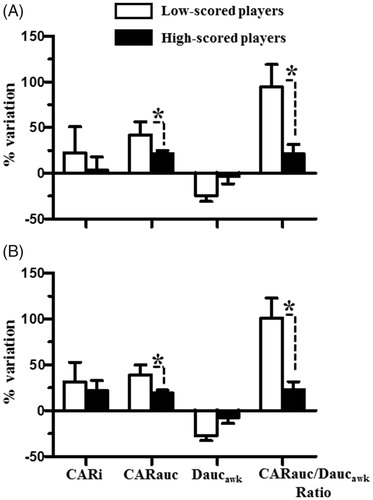Figures & data
Figure 1. Cortisol, DHEA, and the molar cortisol/DHEA (C/D) ratios in the junior men and women players. Cortisol and DHEA concentrations were determined in saliva samples collected on two consecutive days (the day before and on the day of competition), and the molar C/D ratio was calculated for the individual players. The closed circle with a solid line and open circle with a dotted line in each figure represent the data collected the day before and on the day of competition, respectively. (A–C) represent the profiles of cortisol, DHEA, and molar C/D ratio in the junior men players, respectively, and (D–F) represent those values in the junior women players, respectively. Each data point represents the mean and standard error of the mean (SEM).
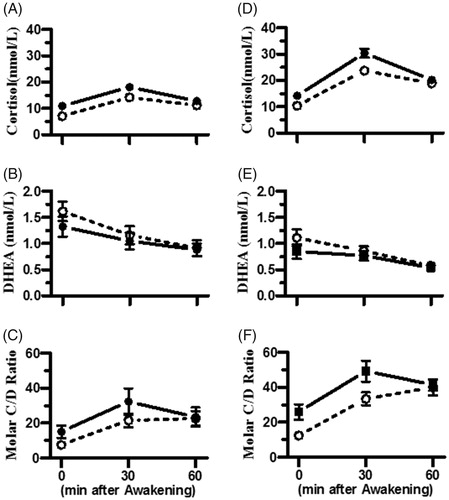
Figure 2. The CARi, CARauc, Daucawk, and molar CARauc/Daucawk ratios of two consecutive days in the junior men and women players. Based on the determined cortisol and DHEA levels, the auxiliary indices (CARi, CARauc, Daucawk, and molar CARauc/Daucawk ratios) were calculated in the individual players. The open and closed bars represent the data obtained the day before and on the day of competition, respectively. The asterisks denote the levels of significance: *p < .05, **p < .01, and ***p < .0001. Each bar represents the mean and standard error of the mean (SEM).
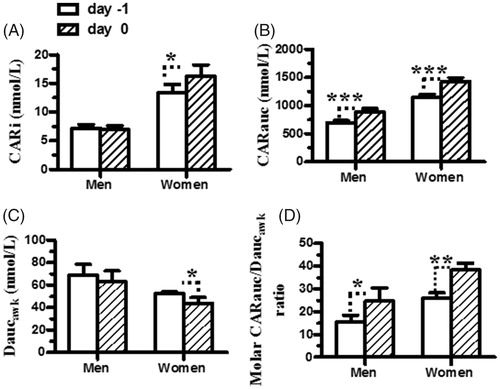
Figure 3. The difference in HPA axis function after the awakening period between the low-scored and high-scored junior men players. They were categorized into two subgroups based on their shooting scores: low-scored (score < mean values of the group scores, open bar) and high-scored (score > mean values of the group scores, closed bar) players; the differences in the CARi (A), CARauc (B), Daucawk (C), and molar CARauc/Daucawk ratios (D) between the low- and high-scored players were compared. The asterisk denotes the levels of significance: *p < 0.05. Each bar represents the mean and standard error of the mean (SEM).
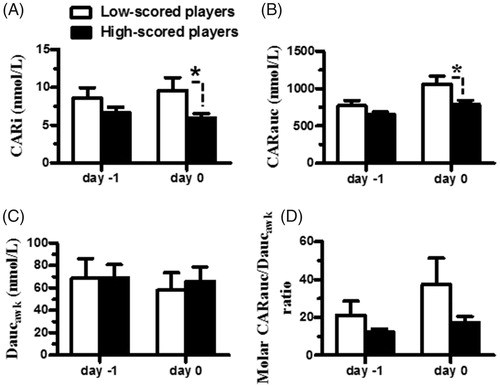
Figure 4. The difference in the HPA axis function after the awakening period between the low-scored and high-scored junior women players. The women players were categorized into two subgroups based on their shooting scores: low-scored (score < mean values of the group scores, open bar) and high-scored (score > mean values of the group scores, closed bar) players; the differences in the CARi (A), CARauc (B), Daucawk (C), and molar CARauc/Daucawk ratios (D) between the low- and high-scored players were compared. The asterisk denotes the levels of significance: *p < .05. Each bar represents the mean and standard error of the mean (SEM).
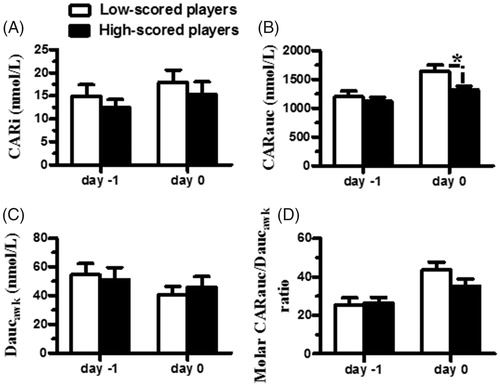
Figure 5. The difference in the percent variation between the low- and high-scored players. The players were categorized into two subgroups based on their shooting scores: low-scored (score < mean values of the group scores, open bar) and high-scored (score > mean values of the group scores, closed bar) players. The percent variations in the CARi, CARauc, Daucawk, and molar CARauc/Daucawk ratios across two consecutive days were calculated in the individual players. (A) represents the differences in the percent variations in the CARi, CARauc, Daucawk, and molar CARauc/Daucawk ratios between the low- and high-scored men players and (B) represents the differences in the percent variations of that between the low- and high-scored women players. The asterisk denotes the levels of significance: *p < .05. Each bar represents the mean and standard error of the mean (SEM).
